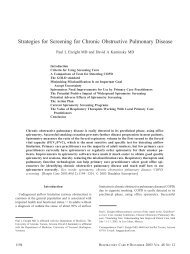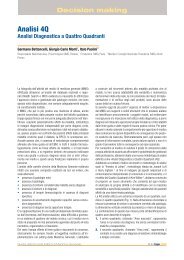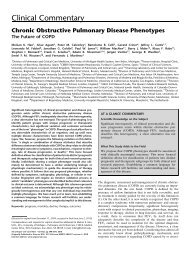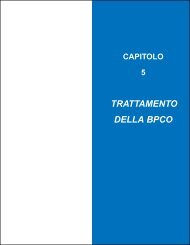Comparison of spirometry criteria for the diagnosis of COPD ... - GOLD
Comparison of spirometry criteria for the diagnosis of COPD ... - GOLD
Comparison of spirometry criteria for the diagnosis of COPD ... - GOLD
Create successful ePaper yourself
Turn your PDF publications into a flip-book with our unique Google optimized e-Paper software.
W.M. VOLLMER ET AL.<br />
<strong>COPD</strong> AND SMOKING-RELATED DISORDERS<br />
An obvious limitation <strong>of</strong> this analysis is <strong>the</strong> lack <strong>of</strong> a gold<br />
standard against which to assess our putative definitions <strong>of</strong><br />
<strong>COPD</strong> (indeed, a more accurate descriptor <strong>of</strong> what we are<br />
measuring may simply be chronic airflow limitation).<br />
None<strong>the</strong>less, it is possible to evaluate how alternative definitions<br />
per<strong>for</strong>m in individuals who have a low a priori<br />
probability <strong>of</strong> disease. Our results confirm previous reports<br />
that <strong>the</strong> fixed ratio criterion lacks specificity and that, as age<br />
increases, increasingly misclassifies apparently healthy neversmokers<br />
as having <strong>COPD</strong> [2, 7–10, 12]. This pattern <strong>of</strong><br />
(apparent) misclassification with increasing age was greatly<br />
muted by adding <strong>the</strong> requirement that <strong>the</strong> FEV1 % pred be<br />
below a defined threshold, or by replacing <strong>the</strong> fixed ratio<br />
criterion with a criterion that <strong>the</strong> FEV1/FVC be below <strong>the</strong> LLN<br />
(fig. 2). However, only <strong>the</strong> method requiring both an FEV1/<br />
FVC below <strong>the</strong> LLN and a low FEV1 (measured as ei<strong>the</strong>r<br />
FEV1,LLN or FEV1 ,80% pred) largely eliminated this agerelated<br />
increase.<br />
The upward trend that still persists in figure 2 even with our<br />
‘‘best’’ definitions <strong>of</strong> <strong>COPD</strong> may reflect <strong>the</strong> fact that our<br />
‘‘healthy’’ never-smokers did include some individuals with<br />
symptoms. As noted below, this was a pragmatic decision due<br />
to <strong>the</strong> limited number <strong>of</strong> never-smokers at some sites. The fact<br />
that <strong>the</strong> NHANES-III prediction equations were fit to a cohort<br />
whose upper age limit was 80 yrs also may create an upward<br />
bias <strong>for</strong> very old individuals that helps explain <strong>the</strong> upward<br />
drift in figure 2. However, ,4% <strong>of</strong> <strong>the</strong> BOLD cohort were aged<br />
o80 yrs; in addition, <strong>the</strong> NHANES-III prediction equations <strong>for</strong><br />
FEV1 include an age-squared term and so allow <strong>for</strong> accelerated<br />
ageing effects.<br />
Notably, <strong>the</strong> recent ATS/ERS statement recommends using <strong>the</strong><br />
LLN <strong>of</strong> <strong>the</strong> FEV1/FVC in place <strong>of</strong> <strong>the</strong> fixed ratio criterion to<br />
diagnose airflow obstruction [21]; a recent paper by SWANNEY<br />
et al. [12], albeit using pre-bronchodilator <strong>spirometry</strong>, also<br />
supports this recommendation. Use <strong>of</strong> both an FEV1/FVC<br />
below <strong>the</strong> LLN and a low FEV1 was consistently associated<br />
with low site-to-site and age-related variation relative to o<strong>the</strong>r<br />
measures, after adjusting <strong>for</strong> known risk factors. Assuming<br />
that variability about <strong>the</strong> prediction equations is stable, using<br />
<strong>the</strong> LLN as a threshold <strong>for</strong> defining low FEV1 should produce<br />
less misclassification [22], although in practice <strong>the</strong>se two<br />
measures per<strong>for</strong>med similarly.<br />
The results <strong>of</strong> our study also add to <strong>the</strong> evidence suggesting<br />
that, without both a low FEV1/FVC and a low FEV1,<br />
confidence is low that a true lung function abnormality (or<br />
airway disease) exists. The current <strong>GOLD</strong> stage 1 classification<br />
was based solely on expert opinion, not on evidence <strong>of</strong> airway<br />
disease or subsequent rapid loss <strong>of</strong> lung function. Patients with<br />
<strong>GOLD</strong> stage 1 do not have reduced exercise capacity [23].<br />
Among Lung Health Study participants, a rapid fall in FEV1<br />
was not seen when baseline FEV1 was .70% pred [24].<br />
Apart from <strong>the</strong> fixed ratio criterion, <strong>the</strong> competing measures<br />
we evaluated all require use <strong>of</strong> prediction equations. One <strong>of</strong><br />
<strong>the</strong> purported benefits <strong>of</strong> <strong>the</strong> fixed ratio criterion is that it does<br />
not rely on such equations. However, as SWANNEY et al. [12]<br />
note, this easy-to-apply definition is only valid at age ,50 yrs.<br />
In addition, <strong>the</strong> fixed ratio criterion is not necessarily easier to<br />
use in practice, since even inexpensive pocket spirometers<br />
include a microprocessor that calculates <strong>the</strong> appropriate LLN<br />
<strong>for</strong> FEV1/FVC, FEV1/FEV6 and FEV1. Lastly, even <strong>GOLD</strong><br />
relies on prediction equations to stage disease, so any<br />
advantage <strong>of</strong> <strong>the</strong> fixed ratio in terms <strong>of</strong> its simplicity<br />
disappears as soon as one looks at clinically relevant<br />
impairment (nominally <strong>GOLD</strong> stage 2 or higher). The only<br />
way to overcome <strong>the</strong> limitations <strong>of</strong> <strong>the</strong> current fixed ratio<br />
criterion while still avoiding <strong>the</strong> need <strong>for</strong> prediction equations<br />
would be to establish a series <strong>of</strong> separate fixed ratio cut points<br />
<strong>for</strong> different ages.<br />
The question <strong>the</strong>n arises, what is a suitable prediction equation<br />
<strong>for</strong> any given population, and what if normative prediction<br />
equations do not exist <strong>for</strong> that population? While <strong>the</strong><br />
documented variability in lung function that exists among<br />
‘‘healthy’’ never-smokers in different racial groups may reflect,<br />
at least in part, true genetic differences in <strong>the</strong>se populations, it<br />
also may represent <strong>the</strong> cumulative effect <strong>of</strong> environmental<br />
exposures, including childhood factors. For this reason, BOLD<br />
chose to use a single set <strong>of</strong> sex-specific prediction equations <strong>for</strong><br />
all subjects in all sites. We chose <strong>the</strong> US NHANES-III equations<br />
<strong>for</strong> Caucasian adults because <strong>the</strong>y were derived from a large<br />
study conducted in a diverse population with rigorous<br />
attention to quality control. We observed similar prevalence<br />
estimates using equations derived from Norway’s Hordaland<br />
County Respiratory Health Study [20] in place <strong>of</strong> <strong>the</strong><br />
NHANES-III equations.<br />
The PLATINO study (Latin American Project <strong>for</strong> <strong>the</strong><br />
Investigation <strong>of</strong> Obstructive Lung Disease), conducted in five<br />
Latin American countries using methods similar to those <strong>of</strong> <strong>the</strong><br />
BOLD study, used site-specific prediction equations [25]. In<br />
BOLD, <strong>the</strong> use <strong>of</strong> local prediction equations led to prevalence<br />
estimates 2–3 percentage points lower, on average, than those<br />
based on a single, common equation. Whe<strong>the</strong>r this means that<br />
<strong>the</strong> BOLD prevalence estimates overestimate <strong>the</strong> ‘‘true’’<br />
estimate, or <strong>the</strong> local equations underestimate it, we cannot<br />
say, but on balance we prefer to maintain <strong>the</strong> site-to-site<br />
variation and see if it can be explained by o<strong>the</strong>r risk factors.<br />
Because our local equations were fitted to individuals aged<br />
o40 yrs, while <strong>the</strong> NHANES-III equations were fitted to<br />
adults aged o18 yrs, <strong>the</strong> <strong>for</strong>mer may better describe <strong>the</strong><br />
accelerated ageing that is known to occur in healthy adults.<br />
Also, we included symptomatic individuals in our prediction<br />
equations as long as <strong>the</strong>y did not report diagnosed disease,<br />
whereas <strong>the</strong> NHANES-III equations required individuals to be<br />
asymptomatic. Since <strong>the</strong>re can be large discrepancies between<br />
prediction equations based on individuals with and without<br />
major respiratory symptoms [26], this may also help to explain<br />
<strong>the</strong> somewhat lower prevalence estimates between <strong>the</strong> two<br />
approaches. One final consideration relating to <strong>the</strong> use <strong>of</strong> sitespecific<br />
prediction equations, particularly if reliable normative<br />
equations <strong>for</strong> that population do not exist, is that <strong>the</strong> resulting<br />
estimates may be highly variable owing to limited sample<br />
sizes. For instance, despite relatively large sample sizes from<br />
each site, <strong>the</strong> number <strong>of</strong> healthy never-smokers available to<br />
build our prediction equations was very limited in some sites<br />
due to extremely high rates <strong>of</strong> ever having smoked.<br />
Considerable attention is now being paid to <strong>the</strong> use <strong>of</strong> <strong>the</strong><br />
FEV1/FEV6 as an alternative to <strong>the</strong> FEV1/FVC, particularly in<br />
older, less healthy populations <strong>for</strong> whom achievement <strong>of</strong> a<br />
c<br />
EUROPEAN RESPIRATORY JOURNAL VOLUME 34 NUMBER 3 595





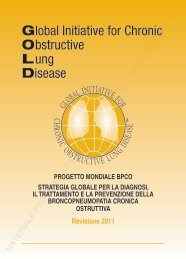
![Di Bari [NO].pdf - GOLD](https://img.yumpu.com/21544924/1/190x143/di-bari-nopdf-gold.jpg?quality=85)


